Descripción
Este texto de Ecuaciones Diferenciales Elementales integra la teoría subyacente, los procedimientos de solución, y los aspectos computacionales y numéricos de las ecuaciones diferenciales en una forma perfecta. Por ejemplo, cada vez que se introduce un nuevo tipo de problema (como ecuaciones de primer orden, ecuaciones de orden superior, sistemas de ecuaciones diferenciales, etc.) el texto comienza con la base teorema de existencia y unicidad.
Esto proporciona al alumno el marco necesario para comprender y resolver ecuaciones diferenciales. La teoría se presenta lo más sencilla posible con un énfasis en cómo usarla. La tabla de contenido es amplia y permite una mayor flexibilidad para los instructores.













Déjanos un comentario
No hay comentarios